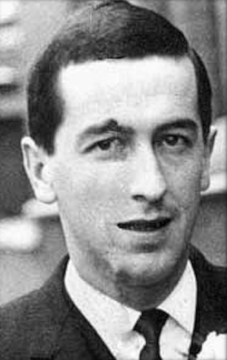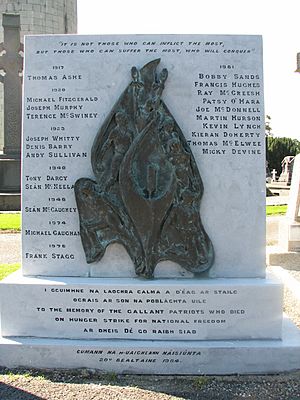Frank Stagg (Irish republican) facts for kids
Quick facts for kids
Frank Stagg
|
|
|---|---|
| Proinsias Stagg | |
 |
|
| Born | 4 October 1941 Hollymount, County Mayo, Ireland
|
| Died | 12 February 1976 (aged 34) |
| Cause of death | Hunger strike |
| Organisation | Provisional IRA |
| Known for | Hunger strike of 62 days, from 14 December 1975 |
| Relatives | Emmet Stagg (brother) |
Frank Stagg (Irish: Proinsias Stagg; born October 4, 1941 – died February 12, 1976) was an Irish republican from County Mayo, Ireland. He was a member of the Provisional Irish Republican Army (IRA). Stagg died in 1976 while on a hunger strike in Wakefield Prison, England. His hunger strike lasted for 62 days. He was one of many Irish republicans who died during hunger strikes in the 20th century.
Contents
Frank Stagg's Story
Early Life and Background
Frank Stagg was born in Hollymount, County Mayo, in 1941. He was the seventh of thirteen children in his family. His father and uncle had both fought in earlier Irish conflicts. Frank's brother, Emmet Stagg, later became a politician in Ireland.
Frank went to primary school at Newbrook and secondary school at CBS Ballinrobe. After school, he worked as an assistant gamekeeper. He then moved to England to find work. In England, he first worked as a bus conductor and later became a bus driver. In 1970, he married Bridie Armstrong, who was also from County Mayo.
Joining the IRA
In 1972, Frank Stagg joined the Sinn Féin political party in Luton, England. Soon after, he became a volunteer with the Provisional Irish Republican Army (IRA).
In April 1973, Stagg was arrested with six other people. They were accused of being part of an IRA group planning attacks in Coventry. He was tried in court and found guilty of criminal damage and planning arson. Frank Stagg was sentenced to ten years in prison.
Life in Prison
Frank Stagg was first sent to Albany Prison on the Isle of Wight. In March 1974, he was moved to Parkhurst Prison. There, he and another man from Mayo, Michael Gaughan, joined a hunger strike. This strike was started by other republican prisoners, including the sisters Marion Price and Dolours Price.
After Michael Gaughan died during that hunger strike, some of the hunger strikers were allowed to return to Ireland. However, Frank Stagg was not allowed to go back to Ireland. He was then moved to Long Lartin Prison. While at Long Lartin, he was kept in solitary confinement because he refused to do prison work. He and his visitors were also subjected to difficult body searches.
To protest these conditions, Frank Stagg started another hunger strike. This strike lasted for 34 days. It ended when the prison governor agreed to stop the strip-searches. After this, Stagg was often unwell and stayed in bed because of a kidney problem.
Why He Went on Hunger Strike
In 1975, Frank Stagg was moved to Wakefield Prison. There, he was again told to do prison work, but he refused. Because of this, he was put in solitary confinement.
On December 14, 1975, Stagg began his final hunger strike in Wakefield. Other republican prisoners joined him. They were protesting because they were not allowed to be moved to prisons in Ireland.
Frank Stagg had specific demands:
- He wanted an end to solitary confinement.
- He did not want to do prison work.
- He wanted to be moved to a prison in Ireland.
The British government did not agree to any of his demands. Frank Stagg died on February 12, 1976, after 62 days on hunger strike.
His Final Wishes and Burial
Frank Stagg's burial caused a lot of discussion and disagreement in Ireland. Republicans, his mother, and two of his brothers wanted him to be buried in a special republican plot. This plot was in Ballina and was next to the grave of Michael Gaughan. This was what Frank Stagg had written in his will while in prison.
However, his wife, his brother Emmet Stagg, and the Irish government wanted him buried in the family plot in the same cemetery. They wanted to avoid any republican involvement in the funeral.
As people waited at Dublin Airport for his body, the Irish government ordered the plane to land at Shannon Airport instead. His body was then taken by helicopter to the church in Hollymount. He was buried near the family plot. Thousands of republicans attended this first burial. The Irish government sent many members of the Irish Defence Forces and police to keep order. Even with this, members of the Provisional IRA attended and fired shots over his coffin, like a military funeral.
Later, a special mass was held for Stagg by republicans in Mayo. Again, many police were present, and many republicans and IRA members attended. A former IRA leader, Joe Cahill, spoke at the ceremony. He promised that Frank Stagg would one day be reburied next to Michael Gaughan.
To stop republicans from moving the body, the first grave was covered with concrete. Police guarded the grave for six months. However, Frank's brother George bought the plot next to it. He put a headstone there, saying the "pro-British Irish government" had taken Frank's body.
About 22 months later, in November 1977, a group of republicans dug into the plot George had bought. They then dug sideways and found Frank's coffin from the first grave. They did this at night. They then reburied his coffin in the republican plot next to Michael Gaughan. They held their own funeral ceremony before leaving. This event is sometimes called the third and final funeral of Frank Stagg.
After this final burial, anonymous letters were sent to some Irish government ministers. The letters said they were "marked out for assassination" because of their government's actions regarding Stagg's burial. Frank Stagg's wife and his brother Emmet were also reported to have been threatened by members of the Provisional IRA because they did not want him buried in the republican plot.


